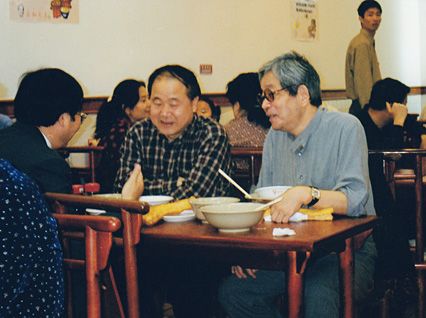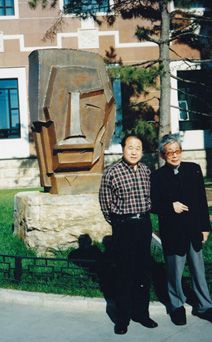
Mo Yan's Creative Reading
Society Culture- English
- 日本語
- 简体字
- 繁體字
- Français
- Español
- العربية
- Русский
Chinese novelist Mo Yan (1955–), winner of the 2012 Nobel Prize in Literature, delivered a Nobel lecture titled "Storytellers" at the Swedish Academy last December. Much of the speech was devoted to recollections of his childhood in the county of Gaomi, Shandong Province, a rural community that appears in his fiction as Northeast Gaomi Township. Mo Yan spoke at length of the poverty, hunger, and solitude that cast a shadow over his early years. No sooner had he completed elementary school than he was obliged to leave school and begin work herding cattle and sheep.
To be sure, such things are seldom seen in today's China, but they were by no means unusual in rural China in the 1960s. Nor were such experiences limited to those born in the remote countryside. During the Cultural Revolution, university entrance examinations were suspended, and even those who made it as far as secondary school received little in the way of education. Upon graduating, the majority of urban youths were sent to live in the countryside—extolled by Mao Zedong as a "vast expanse of heaven and earth"—to be re-educated by farmers and help build socialism in China's rural villages under Mao's "down to the countryside" movement. Mo Yan's experience was the experience of an entire generation. What set him apart was his ability to flourish intellectually in this seemingly barren environment, with rural society as his classroom and the stories of the village elders as his textbook, drawing nourishment from his rural roots like the sturdy wildflowers on the mountainside.
A Voracious Reader
It would be wrong, however, to conclude from Mo Yan's lecture that his writing is simply the fruit of "a long journey of learning through listening," as he put it. He was, in fact, an avid reader from an early age, as we know from such autobiographical essays as "Tongnian dushu" (Childhood Readings) and "Fukena Dashu, ni hao ma" (Hello, Mr. Faulkner). According to these accounts, he had already consumed a huge volume of literature by the time he began his university studies. The sources of Mo Yan's work are extremely diverse, encompassing ancient and modern literature of the East and West. Indeed, in his Nobel lecture, he made special mention of the influence of American novelist William Faulkner (1897–1962) and Colombian writer Gabriel Garcia Márquez (1927–). In "Fukena Dashu, ni hao ma," he describes how reading Faulkner taught him that it was all right for a novelist to invent his own geography, as well as characters and plot lines. It was Faulkner, Mo Yan writes, who "put Northeast Gaomi Township in my novels."
Another major influence, according to Mo Yan, was Japanese novelist Kawabata Yasunari (1899–1972). He writes that he suddenly awoke to the possibilities of fictional description in the mid-1980s upon reading the sentence "A powerful black dog stood on the stepping stones lapping at the [spa] water" in Kawabata's Yukiguni (Snow Country). According to Mo Yan's essay "Shenmi de Riben yu wo de wenxue licheng" (My Literary Experience with Mysterious Japan), Yukiguni was the inspiration for the opening sentence of his short story "Baigou qiuqianjia" (White Dog Swing), which speaks of a "large, gentle, white dog native to Northeast Gaomi Township." This is also the first time Northeast Gaomi Township appears in Mo Yan's fiction.
Creative Reading and the "World of Mo Yan"
Mo Yan writes regretfully that he "did not continue his schooling after elementary school," and that he "was never educated at a proper university"—unlike his older brother, who graduated from college before the Cultural Revolution ("Wo de daxue" [My College Education]). Yet ultimately he did complete secondary school and college, which is rare among those who came of age during the Cultural Revolution. In this respect, Mo Yan seems to be exaggerating his deprivation somewhat.
Mo Yan received his higher education in the Literature Department of the Military Art Academy. Unlike the literature departments at most universities, this one was dedicated to nurturing professional writers and counted a substantial number of published authors among its entering students. Most students who enrolled there did so not with the aim of learning more about the lives and ideas of major literary figures, their impact, or their place in literary history but to develop their own writing skills and further their literary careers. Within this academic culture, Mo Yan developed a unique talent for reading as well as writing. By his own account, he could grasp the basic point of a work of literature—even a book by his beloved Faulkner—after reading a few pages, after which he would cast the book aside ("Fukena Dashu, ni hao ma").
One must suppose that he read Kawabata Yasunari in the same fashion. When Mo Yan traveled to Japan for the first time in 1999, he made a point of visiting an inn on the Izu Peninsula, a locale featured in Kawabata's famous story "Izu no odoriko" (The Izu Dancer). He also paid his respects at the house where Kawabata's friend Kajii Motojirō (1901–32) wrote his famous short story Remon (The Lemon). As Mo Yan listened to his guide's narrative, he thought of all the time Kawabata and Kajii must have spent on that desolate mountainside discussing literary matters. Moved by the friendship of these two writers, he imagined he saw "the spirits of the two men, one old and one young, walking along the winding mountain path beneath deep night skies sparkling with stars" ("Shenmi de Riben yu wo de wenxue licheng").
In point of fact, Kawabata was only two years older than Kajii and was still fairly young when Kajii died. But Mo Yan had drawn a mental portrait of an old Kawabata and a young Kajii, and that was the image that appeared before him. Perhaps his method of reading was similar to that of the ancient Chinese poet Tao Yuanming (c. 352–427), who wrote in his autobiographical sketch Wuliu xiansheng yun (Story of the Master of the Five Willows) that he "liked to read but did not try too hard to understand." Mo Yan seems to have discovered things in literature inaccessible to the vast majority of readers, conjuring up strange visions and fusing scenes from Faulkner and Kawabata into a private literary landscape of his own creation. It is an approach that I call "creative reading."
Fertile Friendship with Ōe Kenzaburō
 Mo Yan (center), Ōe Kenzaburō, and the author in Beijing in 2000.
Mo Yan (center), Ōe Kenzaburō, and the author in Beijing in 2000.
The fact is that Chinese writers of Mo Yan's generation generally had no choice but to read foreign literature in translation. Their access to such translations was a blessing, but it was quite limited. Mo Yan had barely heard of Ōe Kenzaburō (1935–), one of Japan's most famous contemporary writers, until the latter was awarded the Nobel Prize in Literature in 1994. In his Nobel lecture Ōe said, "By sharing old, familiar yet living metaphors I align myself with writers like Kim Chi-ha of Korea, Zheng Yi and Mo Yan, both of China" as a representative of "an Asia impregnated with ever-lasting poverty and a mixed-up fertility" ("Japan, the Ambiguous, and Myself"). Thereafter, Chinese translations of Ōe Kenzaburō's works began to appear in large numbers.
Ōe did not actually meet Mo Yan until the autumn of 2000, when he visited Beijing at the invitation of the Chinese Academy of Social Sciences. The two greeted each other like old friends, but owing to Ōe's extremely busy schedule, they had little opportunity to become better acquainted on that occasion.
Then in 2002, Ōe returned to Beijing for the filming of an NHK (Japan Broadcasting Corporation) documentary on Mo Yan. When the party that met Ōe at the airport saw his suitcase stuffed with books by Mo Yan in various languages—Chinese, Japanese, English, French, and so forth—they were deeply impressed by the gravity and industry that the famous Ōe Kenzaburō brought to his subject.
Cutting short his stay in Beijing, Ōe travelled to Mo Yan's hometown in Gaomi. Originally, NHK had intended to devote most of the documentary to Ōe's commentary on Mo Yan's work. But by this time, Mo Yan had developed quite an understanding of Ōe's work. "I've been reading Master Ōe's books for the past few years," he said, "and I get the same feeling that I experienced upon reading Garcia Márquez and Faulkner. Perhaps this process will become a part of my novels." (From the NHK documentary "Sakka Bakugen: Nōson yo kagayake!" [Writer Mo Yan: Shine, Rural Villages!]).
 Mo Yan (left) and Ōe Kenzaburō in 2000, in front of the China Modern Literature Museum, Beijing.
Mo Yan (left) and Ōe Kenzaburō in 2000, in front of the China Modern Literature Museum, Beijing.
In 2009, Mo Yan published the novel Wa (Frog), set in Northeast Gaomi Township. The story's protagonist is a gynecologist and the aunt of the first-person narrator. Over the course of her long career, she has brought thousands of new lives into the world, but she has also destroyed thousands as a faithful tool of the Chinese government's one-child policy. The novel depicts a complex character—simultaneously a giver and a taker of life—and the circumstances in which she finds herself. The narrator, moreover, is not some detached observer but a character intermittently involved in the story's action, whose cowardice makes him an indirect accessory to infanticide.
Each chapter of Wa opens with a letter in which the narrator relates the events of the past with pain and regret. These letters are addressed to a distinguished Japanese writer, here given the name of Sugitani Yoshihito. We learn, in fact, that the narrator's initial impulse to atone for his guilt was inspired by Sugitani and his acceptance of responsibility for the role his own father played in Japan's war of aggression against China. If we may judge by this, Mo Yan's debt to Ōe Kenzaburō lies not so much in any narrative or stylistic devices found in Ōe's fiction as in the deeply inspirational character of the man himself.
(Originally written in Chinese on January 24, 2013.)
Yukiguni Ōe Kenzaburō Nobel Prize Mo Yan Shandong province Gaomi Red Sorghum William Faulkner Gabriel Garcia Marquez Cultural Revolution down to the countryside rural villages Frog Sugitani Yoshihito